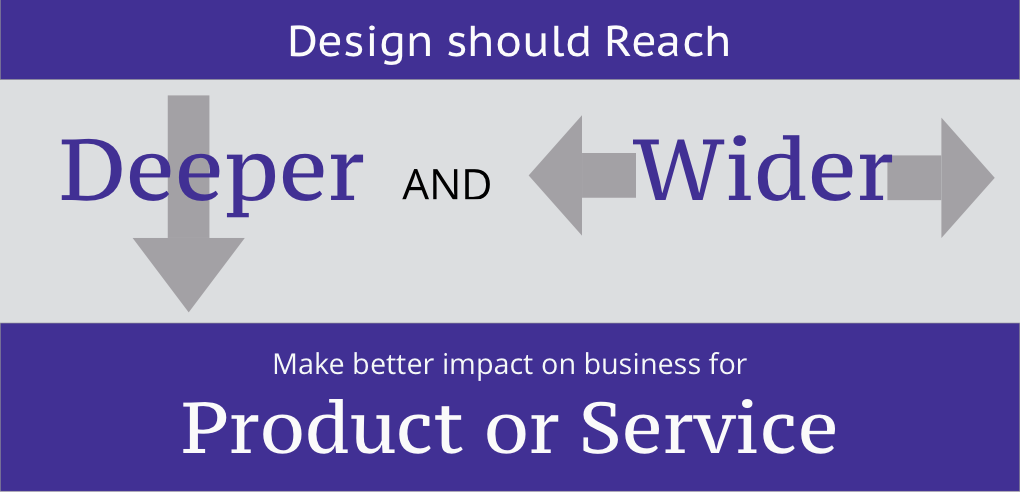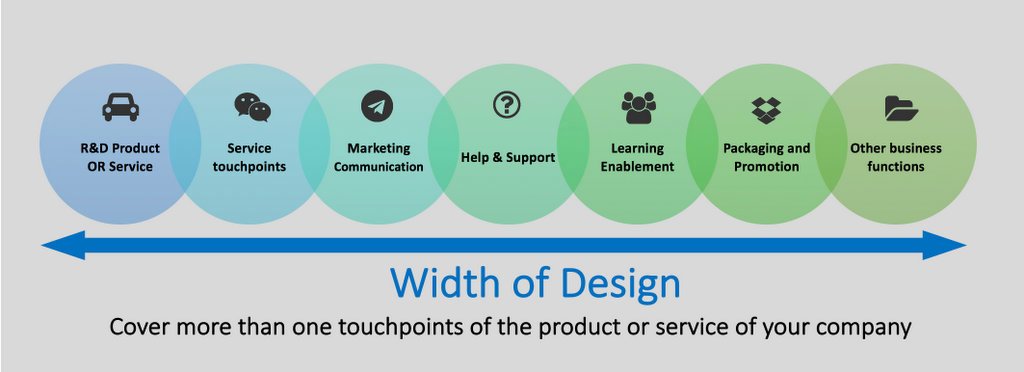2017

Design can increase impact with Deep, and Wide approach
Design in the tech industry is maturing thru last 20+ years
Designers are reaching ‘Deeper’ in the product and services to make a better business impact.
Depth of design: for Software product or service
- Good looks: The basic looks of the product, the branding choice of images, color, icons, and typically all the visual elements that contribute to how the product looks
- Usability and Navigation: Ease of use, find ability, and simplicity of navigation of the interfaces, processes involved
- User experience: The complete experience of the product or service, from familiarization, to getting started to task completion. All of these user journeys build a delightful user experience.
- Features and functionality: Decisions regarding which functionality make sense for the product or service. what features will help user complete his task delightfully
- Core value preposition: Clear definition of the value preposition of the solution has to be built, articulated, presented and validated with users and customers.
- User pain points: Understanding what business problems the product or service aims at solving, which is the most important pain area that users need solution for is important. What is more important is which solution will customers pay for.
Now on this list of facets, where can the design team influence? is it the looks, Usability and User experience level? Does your Design team completely own these three levels? then yes I would say you are on the right path. Most design teams typically OWN 1 and 2 , and attempting to own the 3. completely. Thats where most design teams are in my opinion.
The deeper design teams REACH, the better impacts they can create on business. Does your design team get to influence 4, 5, and 6? Thats where design teams should head. Having clear understanding of which features make more business sense, is important. More importantly, does the design team reach out to users, and customers, understand their business pain areas? After understanding of the pain areas, are you involved in articulating the value proposition?
Design teams empowered to understand and influence the deepest facets of the product will surely have a much better business impact. So Designers, Dig Deeper to hit the gold.
The width of the design
Design today is reaching out to a wider department of any software products, or service company
- Product / Service R&D: Research and Development is the obvious place where you will find most of the design teams. most R&D centers flaunt a UX design department, who is responsible for the complete experience of the product or service.
- Service touch points: Are all of your service touch points covered by design teams? yes, a complete Service Design approach could help build a solid service.
- Marketing Communication: The company website, branding, and marketing communication definitely needs attention from your design team. Sometimes an external branding agency could handle this better than in-house team simply because of wide experience in building brands, In any case, your Marcom surely needs design
- Help & Support: Designing a user-friendly, contextual help is an important task, and definitely needs design inputs. Whether it is the Help and Documentation portal, or UI Familiarization tools, or contextual help. either ways, needs to be covered by Design. Most support functions also need to build their own tools, and software for support engineers, or customers to track their support requests. If these support tools areDesigned well, will surely impact the quality of support.
- Learning Enablement: Most complex enterprise applications have their own learning, and enablement mechanisms, Product and feature enablement, to customers, users, and partners is becoming extremely important in todays world. Learning courses, Content, instructional design, or sometimes simple videos for learning how to use your product or service.
- Packaging and Promotion: Packaging design is a complex task of bundling the products or service modules in sellable packets. Knowledge of detailed needs of the industry, and communication design are the basic ingredients of this type of design.
- Other business functions: There could be other business functions in an organization which might benefit from design. User communities, Support forums, Marketplaces and Partner portals are some of the tools or touch points for the customers, where users discuss and learn about your products, services. Like other touch points, if a design team could cover these, will create a unified smooth experience through the lifecycle.
Typical Lifecycle of a customer (and User)
- Product / Service awareness
- Acquiring new customers
- Engaging: communicating value proposition
- Installation and First-time use
- Getting started and regular use
- Contextual Help and documentation
- Product support
- Championing the products
- Adjacent needs, and pain points = Up, and Cross sale
Does your design team cover most of the aspects of the customer lifecycle? If yes, probably your team is already involved in the ‘complete customer experience design’ this is what indicates a WIDER reach of the design team.
To summarize, Does your Design team go sufficiently DEEPER, and cover a WIDER array of business functions than just the R&D? My advice, try to Dig Deeper and go ‘wider’ to increase the BUSINESS IMPACT of your design team

